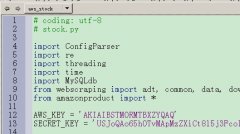原文地址: http://edu.codepub.com/2010/1025/26632.php 随机整数: import random random.randint(0,99) 21 随机选取0到100间的偶数: import random random.randrange(0, 101, 2) 42 随机浮点数: import random random.random() 0.85415370477785668 ran
转自: http://www.codecho.com/comparison-in-python/ 通常我们写: ? 1 if foo is None : pass 这个写法与以下的写法有何区别呢? ? 1 if foo = = None : pass is 当比较的是相同的对象实例时总是返回True。而==则完全决定于__eq__()方法的实现。例如: ?
摘自: http://docs.python.org/library/gzip.html 12.2. gzip Support for gzip files This module provides a simple interface to compress and decompress files just like the GNU programs gzip and gunzip would. The data compression is provided b
http://docs.python.org/library/collections.html#collections.defaultdict 8.3.3. defaultdict objects class collections. defaultdict ( [ default_factory [ , ... ] ] ) Returns a new dictionary-like object. defaultdict is a subclass of the buil
转自: http://blog.csdn.net/cnweike/archive/2011/02/11/6178680.aspx 以一个*开始的参数,代表一个任意长的元组: def mul(*arg): ... print arg ... mul(1,2,3,4,5,6,7,'hello','panfei') (1, 2, 3, 4, 5, 6, 7, 'hello', 'panfei') #一个元组 ***
官方文档 : http://docs.python.org/library/os.path.html os.path.abspath(path) 返回path规范化的绝对路径。 os.path.abspath('test.csv') 'C:\\Python25\\test.csv' os.path.abspath('c:\\test.csv') 'c:\\test.csv' os.path.abspath('../csv\\test.csv'
1) Windows发行版可以考虑用py2exe打包成exe文件。 2)Linux发行版就杯具一点了。现在比较好的方法貌似就是发布pyc中间字节码文件了: python -c import compileall; compileall.compile_dir('d:/alibaba1.1/') 这样就把d:/alibaba1.1/下面所有的py文件编译
在我平时开发用的机器运行py2exe打包的PyQt程序正常。 但是在虚拟机中运行却出现了下面的错误: Traceback (most recent call last): File D:\a.py, line 6, in module from PyQt4 import QtGui, QtCore ImportError: DLL load failed: 由于应用程序配置不正
the default number is131072. we can usefield_size_limit(int number) to set themaximum bytes. e.g. import csv csv.field_size_limit(10000000)
原地址: http://blog.csdn.net/prince2270/archive/2009/10/16/4681299.aspx 在讲述filter,map和reduce之前,首先介绍一下匿名函数lambda。 lambda的使用方法如下: lambda [arg1[,arg2,arg3,...,argn]] : expression 例如: add= lambda x,y:x+y add( 1 ,
方法一: f = open('test.txt') for l in f: ... print l 方法二: f = open('test.txt') for l in f.xreadlines(): ... print l

很好 。。
呵呵,谢谢
非常好
....................
在unix网络编程中看到了关于TCP/IP的一些内容,我感觉还是写的不够。正在下载中,一定
下载地址呢
谢~~